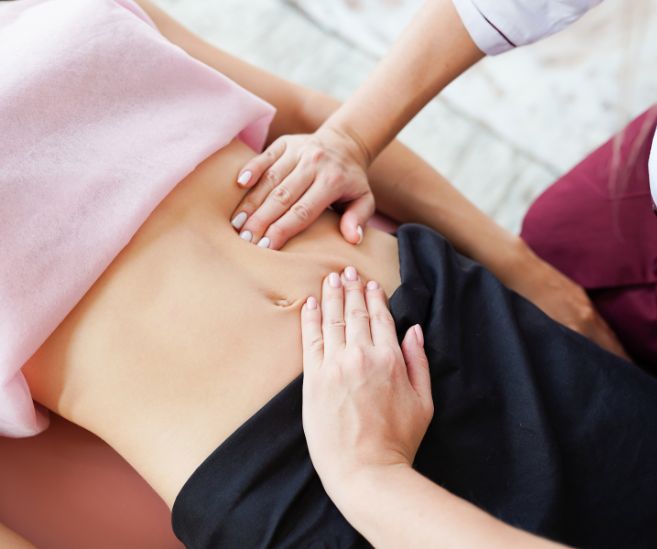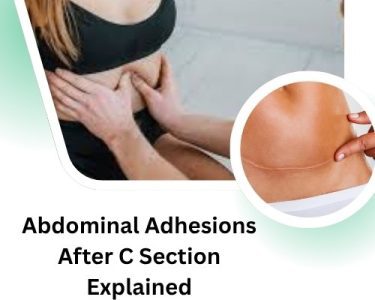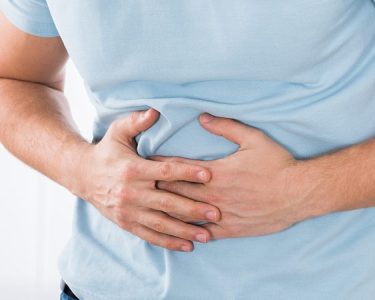Abdominal adhesions are bands of scar tissue that form between abdominal tissues and organs, often as a result of surgery, infection, or inflammation. These adhesions can cause pain, restrict movement, and even lead to complications like bowel obstruction. While surgical interventions may sometimes be necessary, physical therapy offers a non-invasive approach to managing symptoms, improving mobility, and enhancing quality of life. How physical therapy can help with abdominal adhesions and what to expect from treatment.
What are Abdominal Adhesions?
Adhesions are bands of scar tissue that form during the body’s natural healing process. In the abdomen, they develop when inflammation or injury causes tissues or organs to stick together, rather than remaining separate. These adhesions may vary in severity:
- Thin and pliable: Causing minimal interference with organ function.
- Thick and dense: Potentially restricting organ movement or causing complications such as bowel obstruction.
What Causes Abdominal Adhesions?
The most common cause of abdominal adhesions is surgery. During procedures, tissues may become inflamed or damaged, leading to scar tissue formation as the body heals. Other causes include:
- Inflammatory Conditions:
- Appendicitis
- Pelvic inflammatory disease
- Crohn’s disease or ulcerative colitis
- Infections: Bacterial or viral infections in the abdominal cavity.
- Radiation Therapy: Used for cancer treatment, radiation can damage abdominal tissues.
- Endometriosis: A condition where tissue similar to the uterine lining grows outside the uterus, causing inflammation and scarring.
Symptoms of Abdominal Adhesions
Many people with abdominal adhesions experience no symptoms. However, when symptoms occur, they may include:
- Chronic Abdominal Pain: Persistent pain or cramping, particularly after eating.
- Digestive Issues: Bloating, constipation, or difficulty passing stool.
- Restricted Movement: Discomfort during stretching or physical activity.
- Bowel Obstruction: A potentially life-threatening condition where adhesions block the intestines, causing severe pain, nausea, and vomiting.
What is Physical Therapy for Abdominal Adhesions?
Abdominal adhesions are bands of scar tissue that form between the abdominal organs and tissues. These adhesions can develop after surgeries, infections, or other abdominal trauma. While adhesions themselves may not always cause symptoms, they can lead to significant discomfort, pain, and even digestive issues when they interfere with the normal movement of organs in the abdomen. For those dealing with abdominal adhesions, physical therapy can offer a helpful and non-invasive treatment option to manage and reduce symptoms.
The Role of Physical Therapy in Treating Abdominal Adhesions
Physical therapy aims to reduce symptoms associated with abdominal adhesions by improving tissue mobility, relieving pain, and restoring function. Techniques focus on breaking up or loosening adhesions without surgical intervention.
Key Physical Therapy Techniques
- Manual Therapy
Therapists use hands-on techniques such as:- Myofascial release: Gentle, sustained pressure to stretch and release the fascia (connective tissue) surrounding muscles and organs.
- Visceral mobilization: A specialized approach targeting internal organs to improve their movement and function.
- Scar Tissue Mobilization
For post-surgical adhesions, therapists may manipulate the scar tissue to reduce stiffness and increase flexibility. - Stretching and Strengthening Exercises
- Targeted stretches can help improve abdominal and pelvic mobility.
- Core strengthening exercises support the abdominal muscles, reducing strain and improving posture.
- Breathing Exercises
Deep diaphragmatic breathing enhances oxygen flow, reduces tension in the abdominal area, and promotes tissue relaxation. - Ultrasound Therapy
Non-invasive ultrasound therapy may help reduce scar tissue thickness and improve tissue elasticity. - Postural Training
Poor posture can exacerbate symptoms of adhesions. Therapists guide patients in maintaining proper alignment to minimize discomfort.
How Physical Therapy Can Help Abdominal Adhesions
Physical therapy (PT) can play a crucial role in alleviating symptoms caused by abdominal adhesions. The goal of physical therapy for abdominal adhesions is to improve mobility, reduce pain, and promote the healing of affected tissues.
- Improving Range of Motion Adhesions can limit the movement of your abdominal muscles, organs, and connective tissues. Physical therapy techniques can help stretch and mobilize the soft tissue around the adhesions, improving the range of motion. This allows for better organ movement and can relieve the sensation of stiffness and tightness often associated with adhesions.
- Scar Tissue Management One of the primary benefits of physical therapy is the ability to treat scar tissue directly. Through specialized techniques such as deep tissue massage, myofascial release, or soft tissue mobilization, a physical therapist can help break down the fibrous tissue and encourage more functional healing. This reduces the impact adhesions have on the surrounding muscles and tissues.
- Pelvic Floor Therapy Abdominal adhesions, particularly those resulting from pelvic surgeries, can affect the pelvic floor muscles. Physical therapists trained in pelvic health can perform techniques designed to release tightness in the pelvic region, strengthen weak muscles, and reduce pain. This is especially helpful for individuals who experience pelvic pain, discomfort during intercourse, or bladder issues due to adhesions.
- Pain Management Physical therapists use a variety of techniques to manage pain associated with abdominal adhesions. These can include modalities such as heat, cold, ultrasound therapy, or electrical stimulation to relieve pain and inflammation. By addressing the root causes of discomfort, physical therapy can significantly improve a patient’s quality of life.
- Breathing Exercises The deep abdominal muscles are essential for proper breathing. Adhesions can interfere with the movement of these muscles, making deep breathing more difficult. A physical therapist can teach breathing exercises that help activate the diaphragm and abdominal muscles, improving both function and relaxation.
- Postural Correction Abdominal adhesions can also cause posture problems, especially if they limit the mobility of the torso or the abdominal wall. A physical therapist can help teach proper posture techniques to prevent strain on the affected areas and reduce the risk of further injury.
Benefits of Physical Therapy for Abdominal Adhesions
Incorporating physical therapy into your treatment plan for abdominal adhesions can offer numerous benefits:
- Reduced Pain: Through a combination of techniques, physical therapy can help reduce both the severity and frequency of abdominal pain.
- Improved Mobility: Physical therapy helps restore the movement of abdominal muscles and organs, which can alleviate discomfort and improve overall function.
- Avoiding Surgery: For some individuals, physical therapy can reduce the need for surgical interventions, such as adhesiolysis (surgical removal of adhesions).
- Enhanced Quality of Life: Physical therapy not only addresses the physical symptoms of adhesions but also improves mental well-being by enabling better mobility and reducing chronic pain.
What to Expect During Physical Therapy
Your physical therapy journey begins with a thorough assessment of your medical history, symptoms, and physical condition. The therapist will create a personalized treatment plan tailored to your needs. Here’s what a typical session may involve:
- Initial evaluation of abdominal mobility and scar tissue
- Education on self-care techniques, including home exercises
- Progress tracking and adjustments to the treatment plan as needed
Complementary Approaches to Physical Therapy
For optimal results, physical therapy can be combined with other interventions:
- Dietary Adjustments: A fiber-rich diet can alleviate digestive issues linked to adhesions.
- Hydration: Staying well-hydrated supports tissue health.
- Alternative Therapies: Techniques like acupuncture or yoga may complement physical therapy.
When to Seek Medical Attention
While physical therapy is effective for managing symptoms, some cases may require surgical intervention, particularly if adhesions cause bowel obstruction or severe pain. Always consult with your healthcare provider if symptoms persist or worsen.
Conclusion
Physical therapy offers a promising, non-invasive solution for individuals struggling with abdominal adhesions. By focusing on tissue mobility, pain management, and functional restoration, it empowers patients to regain control of their lives and improve their well-being. If you’re experiencing symptoms of abdominal adhesions, consult a licensed physical therapist to explore your options and begin your journey to recovery.




